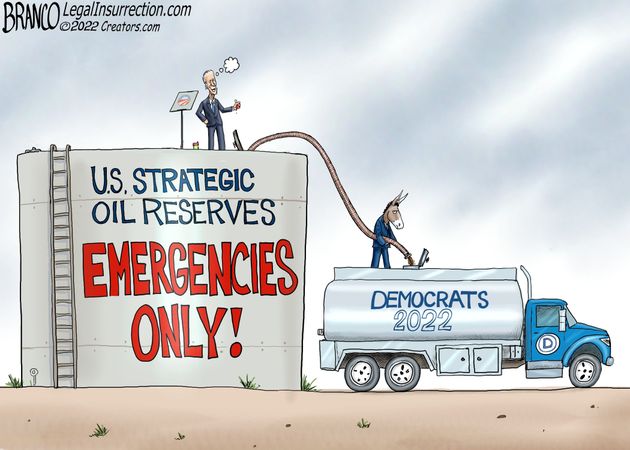YOU SHOULD SUBSCRIBE TO CLIMATE CHANGE WEEKLY.
IN THIS ISSUE:
- Public More Concerned about Energy Prices than Supposed Climate Catastrophe
- Podcast of the Week: Biden Is to Blame for the World’s Food Shortage Crisis and High Prices (Guest: Daren Bakst)
- For China, Coal Remains the Ticket To Growth
- Study Finds Significant Extreme Rainfall Bias
- Green Energy Unsafe for Wildlife, Says Report
- Climate Comedy
- Video of the Week: The Truth About Global CO2 Emissions
- Recommended Sites
Public More Concerned about Energy Prices than Supposed Climate Catastrophe

The inflation rate in the United States is the highest it has been in more than 40 years. Many people living today have never experienced the drop in buying power they are now. Historically high and rising energy prices are having a ripple effect throughout the economy, significantly increasing the prices of food and other essential goods and services.
As described in previous issues of Climate Change Weekly and two recent papers by Heartland Institute scholars, rising food and fuel prices are a direct result of President Joe Biden’s climate and energy policies.
To fight climate change, Biden canceled the Keystone XL pipeline partnership with Canada, imposed a moratorium on new oil and gas leases on federal lands and the U.S. outer continental shelf; cancelled oil and gas leases in the Arctic National Wildlife Refuge, foreclosed drilling on more than half of the National Petroleum Reserve-Alaska, and proposed increasing the federal fees and royalties paid by oil and gas producers. Biden also forced new climate-change restrictions on infrastructure projects like pipelines, while simultaneously making it more difficult and expensive to ship natural gas by rail. He also imposed methane emission restrictions making it harder and more expensive to develop, store, and transport oil and natural gas.
A new survey, conducted by the polling firm Rasmussen on behalf of The Heartland Institute, indicates the public largely understands that high prices and shrinking buying power are the result of the Biden administration’s disdain for U.S. oil and gas production and obsession with fighting climate change—and they are ready for a change, both of policy and leadership. (NOTE: The poll will be released publicly on Monday, but Climate Change Weekly readers get a preview.)
Despite nearly three and a half decades of the public being bombarded daily with alarming claims of a pending climate catastrophe, the Rasmussen/Heartland survey finds only 30 percent of voters believe it is “very likely” climate change will be catastrophic for humans, plants, and animals within next century. Unsurprisingly having been raised on the pablum of false climate claims since birth, the youngest cohort of voters are the most concerned about climate change.
While the so-called climate crisis may not be ringing many alarm bells among most voters, the survey shows, high energy prices certainly are. Eighty-two percent of voters say they are either “very” or “somewhat concerned” about rising energy and gas prices under the Biden administration.
In response, 60 percent of those surveyed, a clear majority, strongly favor or somewhat favor, passing laws to “dramatically increase oil and gas drilling in the United States.” Indeed, by an 18 percentage point margin, survey participants said President Biden and Congress should focus more on “increasing oil and gas drilling to help reduce energy prices” than “limiting carbon dioxide emissions in an attempt to reduce climate change.”
Of the various demographic categories surveyed—age, gender, income range, marital status, parental status, and race—only youths 18 to 39 prioritized limiting carbon dioxide emissions over increasing oil and gas production. But even that was a close call with 18-39 year olds favoring carbon cuts over oil and gas increases by 39 to 37 percent, a mere two percentage point difference.
This survey reiterates the fact that when push comes to shove, for most people, energy- and-economic security trumps climate change when asked which is more important.
The public’s ranking is astute. Data indicates climate change is not worsening weather conditions, human health, or the environment, and the best research indicates continued modest warming poses, at most, ephemeral threats to future planetary and human well-being. By contrast, oil and gas are—and for the foreseeable future will remain—vital to maintaining Americans’ present standard of living and current lifestyles, and to ensuring our continued economic and national security. In addition, if one is concerned about reducing hunger and poverty around the globe, fossil fuels are also crucial to solving those problems, as well.
President Biden’s and congressional Democrats’ popularity and poll numbers are already upside down, especially on bread and butter issues like the economy that matter to voters most at the moment. Accordingly, if they want to have any chance of maintaining their majority in Congress in the mid-terms, they should take this poll seriously. For too long, Democrats have been led by the radical rump of the party, acting as if “The Squad” represents the majority of the public’s desires on energy and climate issues. They don’t now and never have, which this survey confirms.
As proof, another Rasmussen/Heartland survey, released Thursday, found 55 percent of likely voters had a very or somewhat unfavorable opinion of President Joe Biden, compared to just 42 percent holding a very or somewhat favorable opinion of the him. Sixty-one percent of those surveyed said Biden should not run for President again, and likely voters indicated they would vote for either former President Donald Trump or Florida Gov. Ron DeSantis over Joe Biden if a heads up election were held today.
As my colleague Linnea Lueken stated in a recent press release describing the Rasmussen/Heartland survey results, “this poll confirm that Americans have far different priorities than the Biden administration. Americans are worried about being able to afford the fuel that they need to work and live, and they know that our current oil and gas energy infrastructure is insufficient. … Our elected officials should take note.”
SOURCES: The Heartland Institute; The Heartland Institute; Rasmussen/Heartland Institute Survey.
Check Out All Our Presentations in Scotland
Podcast of the Week
Food prices were rising fast in the United States before Russia launched its war in the Ukraine, but the war has exasperated the food shortage problem. People in developing countries are going hungry and shoppers in the U.S. are seeing empty shelves and higher prices.
Daren Bakst of the Heritage Foundation explains that the Biden administration’s climate and energy policies are at fault. They are making it harder and more expensive for farmers to farm and to get food from fields to shelves. Biden claims to care about the poor, but his policies are making their lives harder by bringing hunger into the U.S.
For China, Coal Remains the Ticket To Growth

Economic plans approved at an April 20 meeting of China’s cabinet call for raising coal production by 300 million tons in 2022 alone, equal to 7 percent of the entire output of 2021. And this after China increased coal production 5.7 percent above 2020’s output in 2021.
After repeated failures of wind and solar power in the country in 2020 and 2021 resulted power outages and factory shutdowns, China’s government is bringing more coal online to stabilize power supplies and boost economic growth.
According to NPR, cabinet officials came out of the meeting saying, “[c]oal is important for ‘energy security.’” Simultaneously the Chinese government announced plans to build new coal fueled power plants in order to shore up the power supply.
NPR notes China’s Communist Party has rejected binding greenhouse gas emission reduction commitments despite contributing 26.1 percent of global emissions, more than double the U.S. share.
“This mentality of ensuring energy security has become dominant, trumping carbon neutrality,” said Li Shuo, a senior global policy adviser for Greenpeace commenting on the government’s announcement, according to NPR. “We are moving into a relatively unfavorable time period for climate action in China.”
Also reporting on China’s announcement, Breitbart writes:
China’s state-run Global Times reported on a meeting at which “energy experts” said China spent 2021 “learning a lesson” about inadequate energy supplies and will now unapologetically “push relevant energy projects that have mature conditions and fit the nation’s development needs.”
“In particular, the State Council meeting said that China should support coal as a main energy source by improving review and approval mechanisms on coal production and project construction, as well as releasing advanced capacity,” the Global Times added.
The State Council also decided China will forge ahead with the “orderly” development of nuclear power, approving six new nuclear power plants.
“Onward and upward with coal,” China is effectively saying.
Heartland’s Must-read Climate Sites
Study Finds Significant Extreme Rainfall Bias

New research published in the journal Water indicates current climate models are rife with errors because the data sets on which they rely use poor methods to account for extreme rainfall events.
The authors write, “one of the most frequently conducted analyses in the climate change field could be affected by significant errors, due to the use of rainfall data characterized by coarse time-resolution.”
According to the paper, studies accounting for rainfall amounts during extreme rainfall events suffer from poor or coarse data resolution, with regard to both the maximum depth of rainfall and the time period measured.
The researchers examined data from 39 representative meteorological stations spanning central Italy over the past 100 years. Among the problems they found were that changes in recording systems and their location over time have resulted in an underestimation of historical rainfall amounts. If higher rainfall amounts occurred during extreme events in the past than was recorded, then any upward trend attributed to climate change in recent decades would be biased, inaccurately showing a steeper increase in rainfall amounts and trends during extreme events than occurred. The relative amount and rate of rise in rainfall, if any, since warming has become a concern, would be less than previously believed based on accurate data accounting for rainfall on finer scales and time periods.
After mathematically correcting average underestimation errors in the time series data and running various types of commonly used climatic trend tests, they found the coarse spatial and time analysis:
plays a significant role in the analysis of the effects of climatic change on extreme rainfalls. Specifically, the correction … can change the sign of the trend from positive to negative. Therefore, before conducting any trend analysis … from rainfall data characterized by coarse temporal resolution should always be corrected.
If this research is sound, and data accounting methods for extreme rainfall measurements over the past 100 years for other regions around the globe are similarly flawed, claims that rainfall amounts are increasing at a dangerous or unusual rate due to climate change must be reconsidered. As with faulty temperature projections made by climate models, claims of extreme rainfall increases could just be an artifact of models relying on bad data.
SOURCE: Multidisciplinary Digital Publishing Institute: Water
Green Energy Unsafe for Wildlife, Says Report
A new paper published in Royal Society Open Science should serve as a warning for people and groups concerned about the impact of wind and solar industrial facilities on wildlife—birds and bats in particular—especially as governments push ever greater amounts of “renewable power” onto the electric grid to fight climate change.
The team, comprised of 13 researchers from various U.S. government agencies, universities, and research institutes located in different regions, found many bird species are vulnerable to harm and significant population reductions from large industrial wind and solar facilities.
They “assessed the vulnerability of populations for 23 priority bird species killed at wind and solar facilities in California.” Their research suggests 11 of those species, nearly half of the species tracked, “were vulnerable to population-level effects from added fatalities caused by renewables and other sources.
“Effects of renewables extended far beyond the location of energy production to impact bird populations in distant regions across continental migration networks” said the authors. “Populations of species associated with grasslands where turbines were located were most vulnerable to wind. Populations of nocturnal migrant species were most vulnerable to solar…”
Those eleven species “were either highly or moderately vulnerable, experiencing a greater than or equal to 20 percent decline in the population growth rates with the addition of up to either 1,000 or 5,000 fatalities, respectively.”
Commenting on the study, an article in Pipeline reports, “In the United States, anywhere from 140,000 to 328,000 bird fatalities take place per year at monopole turbines, but the real figure is probably much higher because, as the paper acknowledges, the estimate comes from data gathered a decade ago when installed capacity was only 57 percent of the current figure. Solar energy generation back then, when capacity was only 37 percent of the current figure, caused up to 138,600 birth deaths in the country…”
This research confirms what other reports have found: the government backed push to impose ever greater use of renewable energy sources onto the grid should concern anyone concerned about intact wild ecosystems and the variety of species that inhabit or migrate through them, especially, but not solely, birds and other avian species.
SOURCES: The Pipeline; Royal Society Open Science
Video of the Week: Greenpeace Co-Founder Patrick Moore
Climate Change Roundtable Host Andy Singer and Heartland’s Linnea Lueken and Jim Lakely cover the truth about global carbon dioxide emissions and the indispensable nature of fossil fuels.































